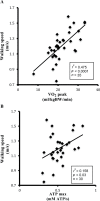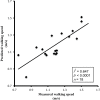Skeletal muscle mitochondrial energetics are associated with maximal aerobic capacity and walking speed in older adults
- PMID: 23051977
- PMCID: PMC3593613
- DOI: 10.1093/gerona/gls196
Skeletal muscle mitochondrial energetics are associated with maximal aerobic capacity and walking speed in older adults
Abstract
Background: Lower ambulatory performance with aging may be related to a reduced oxidative capacity within skeletal muscle. This study examined the associations between skeletal muscle mitochondrial capacity and efficiency with walking performance in a group of older adults.
Methods: Thirty-seven older adults (mean age 78 years; 21 men and 16 women) completed an aerobic capacity (VO2 peak) test and measurement of preferred walking speed over 400 m. Maximal coupled (State 3; St3) mitochondrial respiration was determined by high-resolution respirometry in saponin-permeabilized myofibers obtained from percutanous biopsies of vastus lateralis (n = 22). Maximal phosphorylation capacity (ATPmax) of vastus lateralis was determined in vivo by (31)P magnetic resonance spectroscopy (n = 30). Quadriceps contractile volume was determined by magnetic resonance imaging. Mitochondrial efficiency (max ATP production/max O2 consumption) was characterized using ATPmax per St3 respiration (ATPmax/St3).
Results: In vitro St3 respiration was significantly correlated with in vivo ATPmax (r (2) = .47, p = .004). Total oxidative capacity of the quadriceps (St3*quadriceps contractile volume) was a determinant of VO2 peak (r (2) = .33, p = .006). ATPmax (r (2) = .158, p = .03) and VO2 peak (r (2) = .475, p < .0001) were correlated with preferred walking speed. Inclusion of both ATPmax/St3 and VO2 peak in a multiple linear regression model improved the prediction of preferred walking speed (r (2) = .647, p < .0001), suggesting that mitochondrial efficiency is an important determinant for preferred walking speed.
Conclusions: Lower mitochondrial capacity and efficiency were both associated with slower walking speed within a group of older participants with a wide range of function. In addition to aerobic capacity, lower mitochondrial capacity and efficiency likely play roles in slowing gait speed with age.
Figures





References
-
- Goodpaster BH, Park SW, Harris TB, et al. The loss of skeletal muscle strength, mass, and quality in older adults: the health, aging and body composition study. J Gerontol A Biol Sci Med Sci. 2006; 61: 1059–1064 - PubMed
-
- Newman AB, Kupelian V, Visser M, et al. Strength, but not muscle mass, is associated with mortality in the health, aging and body composition study cohort. J Gerontol A Biol Sci Med Sci. 2006; 61: 72–77 - PubMed
-
- Visser M, Goodpaster BH, Kritchevsky SB, et al. Muscle mass, muscle strength, and muscle fat infiltration as predictors of incident mobility limitations in well-functioning older persons. J Gerontol A Biol Sci Med Sci. 2005; 60: 324–333 - PubMed
Publication types
MeSH terms
Grants and funding
LinkOut - more resources
Full Text Sources
Other Literature Sources
Medical

